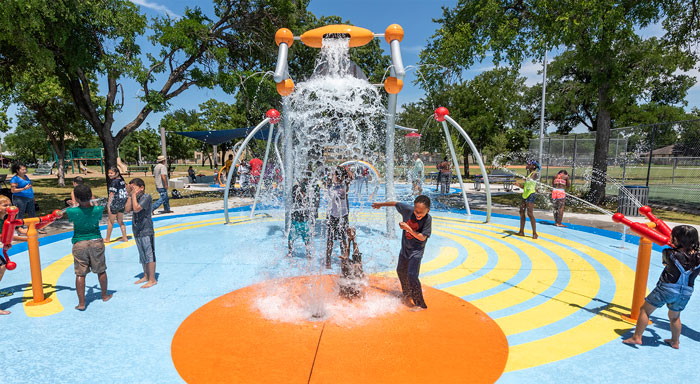It’s hard to imagine any kid out there who wouldn’t want to play with the hose. Spraying, splashing, squirting, soaking—it’s irresistible! Add a hot day to the mix and the temptation to splash and spray becomes even greater. And who are we kidding; adults are tempted to get in on the fun—or at least the cooling off—as well. Which is why splash play areas continue to proliferate and pop up in a wide variety of locations.
“Interesting areas for new splash pads are golf courses, cruise ships and housing condominiums,” said Wyeth Tracy, president of an Ontario, Canada-based spray park manufacturer and supplier. “Theme parks are realizing that with the increase in temperatures, splash pads are a necessity to cool off guests and maintain length of stay.”
With regard to trends, Tracy said smaller features with lighter sprays are preferred in municipal projects to address water consumption. “New innovative themes and creative shapes are always necessary to relieve the boredom of the same old visuals.” And he said they’re “developing more interactive features to add more fun and excitement as we empower the youngsters to create their own water effects.”
Interactivity is at the heart of aquatic play, according to Tracy. “Simple interactivity using simple laminar nozzles is ve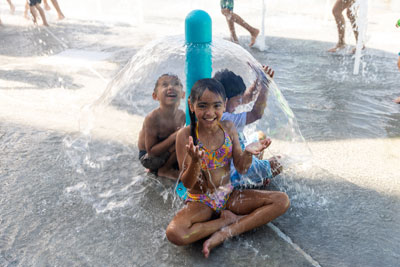 ry interactive as the players stop the flow, making other jets go higher.” Hand-wheel diverters and pull-push buttons can be added to many features, allowing kids to change water sprays or “make certain actions happen like turning wheels, dumping buckets, making spinners spin, etc.
ry interactive as the players stop the flow, making other jets go higher.” Hand-wheel diverters and pull-push buttons can be added to many features, allowing kids to change water sprays or “make certain actions happen like turning wheels, dumping buckets, making spinners spin, etc.
“Hand-crank water shooters and pedaling water bikes or rocking toys with pumps are all examples of interactives,” continued Tracy, powered by a person’s motion, providing a reaction to their action, which is “exciting for the little ones.” He explained that their products are surface-mounted and use a standard set of base flanges, making them easily interchangeable with different features to retrofit or upgrade.
“There are countless ways to create interactive experiences within splash pad designs,” said Aaron Skogen, general manager of a Delano, Minn.-based splash park design, fabrication and construction company. He mentioned a couple products that “combine multiple interactive events all on raised platforms, and include slides, tunnels, sprayers and more.” An interactive water table “empowers kids of all abilities to take control of the water flow.”
He said they also offer a versatile range of interchangeable ground spray nozzles. “Clients can easily unscrew one nozzle and replace it with another to instantly create a new water effect. While less common, above-ground features and structures can also be swapped out, provided they share the same flange diameter.”
Many systems are now being designed with a feature called “sequencing,” allowing venues to conserve water by regulating the flow to only a few features at a time, explained Skogen. “For example, if the total feature flow rate is 120 gallons per minute, sequencing can significantly reduce overall water consumption.” Additionally, this approach enhances interaction on the splash pad by dynamically shifting the water from one feature to another, “creating an engaging and ever-changing play experience.”
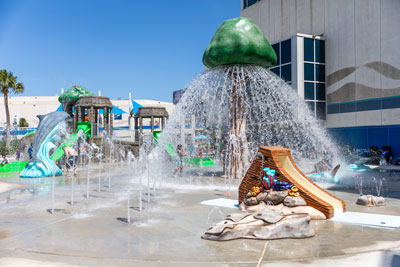 Chris Thomas, director of marketing for a San Marcos, Texas-based designer and manufacturer of interactive water features and aquatic play equipment said that multilevel structures are very popular in aquatic centers and spray parks, and he advised operators to consider if specialized surfacing or supervision will be needed. “Make sure to include a mix of other spray features that are ADA-accessible and meet the needs of all ages and abilities.” And he pointed out that moving parts manipulated by guests can mean more maintenance, so ensure that you have the staff and budget to support this.
Chris Thomas, director of marketing for a San Marcos, Texas-based designer and manufacturer of interactive water features and aquatic play equipment said that multilevel structures are very popular in aquatic centers and spray parks, and he advised operators to consider if specialized surfacing or supervision will be needed. “Make sure to include a mix of other spray features that are ADA-accessible and meet the needs of all ages and abilities.” And he pointed out that moving parts manipulated by guests can mean more maintenance, so ensure that you have the staff and budget to support this.
Kids love waterslides, and according to Barb Lapierre, regional sales manager with a Quebec, Canada-headquartered splash pad company, venues are increasingly incorporating waterslides with pool-less run-out options. “These features are popular because they provide the fun of waterslides without the need for deep pools, making them safer and accessible for all ages.”
As municipalities look for cost-effective ways to reinvigorate their aquatic offerings, many are rethinking underutilized kiddie pools. “Wading pools of yesterday are still being renovated into splash pads,” said Tracy. “These facilities are ripe for the transformation because the excavation is already done to accept the piping, and often the new water supply infrastructure will fit adequately in the existing mechanical room.”
For those considering adding splash play areas, Skogen suggested some considerations in the pre-design phase, including “evaluating key factors such as site locations, access to utilities (waste, water and power) and the surrounding environment. For example, in areas prone to heavy winds, we may advise against the use of misting features,” as the mist can easily be carried off. “Additionally, we assess the demographics of potential users to ensure the creation of age-appropriate zones,” offering “gentle water features for toddlers to more dynamic elements for older children and adults.”
Choosing a mechanical system is the most critical decision when planning splash pads, as it significantly impacts budgets. Flow-through systems connect the splash pad’s pipeline to the city’s water supply, and after water drains from the pad it either goes into the sewer system or is repurposed for irrigation. Recirculating systems filter and sanitize water within an underground storage reservoir, and water in these systems needs regular sanitization—including chlorine and UV—before returning to the splash pad.
Skogen said that a flow-through system with a total feature flow rate of 120 gallons per minute “can use approximately 1.3 million gallons of water per month.” A recirculating system with a flow rate of 300 gallons per minute “consumes about 9,000 gallons per month. Based on average utility costs, we estimate a payback period of about 6.8 years when opting for a recirculating system… assuming the client pays for their water.” 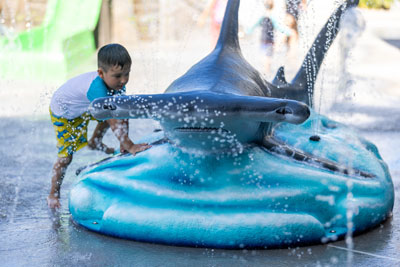
He pointed out that clients who use pass-through systems often implement water reuse strategies, and recirculating systems “necessitate daily water chemistry checks, cartridge changes or backwashing of the filtration system, and regular maintenance of the mechanical system.”
Skogen’s company offers a prefabricated water recirculation system that arrives fully assembled. The system takes days to install, compared to the weeks or more required for conventional site-built systems, according to Skogen. “This system eliminates the complexity of coordinating multiple subcontractors by providing a single technical resource for the entire installation and ongoing maintenance.” Additionally, the system is designed to be repeatable, “allowing municipalities to easily train their staff on one site and apply that same knowledge to identical systems at other locations.”
There is also a non-electrical domestic water delivery system available for sites without power. “It’s become incredibly popular and is perfect for pocket parks, campgrounds, smaller communities or anyplace where adding electrical is difficult,” said Skogen. While it’s limited to a 60 GPM total feature flow rate, “it can still create remarkable splash play environments.” He said they’re also seeing clients specify two or even three systems on a single splash pad to “create distinct zones and enhance the play experience.”
Tracy said they are continually looking to reduce water usage and prefer to “recirculate the water rather than send it to waste.” Additionally, “Smaller, more efficient water features use less water.” And he said that with automation, less energy is used, since sequencing—where only some water features are running at any one time—allows for smaller pumping systems.
Another trend is the use of “cooling products”; water features that refresh and cool the surrounding air and passersby with a fine mist. Lapierre’s company offers these, and she said they are indeed becoming more popular. “They’re valued not just for play but also as a means for anyone to find a cooling respite, especially in urban areas where green spaces and water features are limited.”
She explained how cities are grappling with the urban heat island effect, where built-up areas are significantly warmer than surrounding rural areas, and these water features can “offer a much-needed cooling effect.” She said many places are integrating these features with seating and shade to create “comfortable cooling zones,” including public parks, shopping centers, urban plazas, residential complexes, schools and universities, master plan communities, and hotels and resorts.
She mentioned destinations such as the La Ronde/Six Flags amusement park in Montreal, which has many entertainment offerings, as “ideal locations for cooling zones… allowing people to stay onsite longer as they can be more comfortable for longer periods of time.”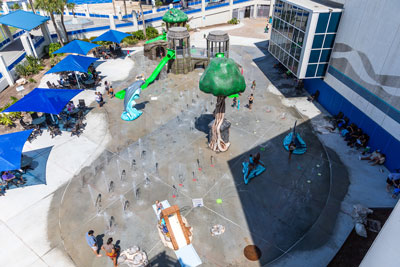
The cooling products are inclusive, as anyone can enjoy the benefits of them without “full immersion,” said Lapierre, and she pointed out that the energy-efficient aspects are significant, “especially in the context of sustainability and environmental impact.” The products use low-flow nozzles, and feature on-demand activation, therefore they operate only when needed, not continuously. A flow control feature adjusts water flow based on usage. With smart connectivity, the system can be monitored and adjusted remotely.
Playable fountains offer another aspect of splash play. Whereas fountains are mostly “passive visual experiences… aside from an occasional dip of a hand or toe to cool off,” Lapierre’s company offers an innovative twist to these amenities, and she said these are becoming more of a common feature. “They’re an innovative twist on traditional fountains, transforming them into immersive, multisensory and interactive play experiences.”
She said they’re found in civic plazas, downtown cores, city centers and more, “where they add a dynamic element to the urban landscape and enhance the public realm. The ability to tailor the design, lighting and sequencing gives each project a unique signature, making them versatile for different settings.”
Thomas said that fountains that might be incorporated into splash play areas are “commonly referred to as interactive fountains or deck fountains. Some customers intend to have extended hours for play; illuminated ground sprays… are good solutions for these applications. These are commonly used in plazas, courtyards, public parks and other urban spaces where people gather.”
Incorporating LED lights and a variety of nozzles can offer up options for a variety of displays. “We commonly choreograph water shows to music to enhance the total experience with specialized software and controls.”
He explained that filtration systems for fountains are “usually buried in vaults or equipment rooms.”
Skogen said they’re noticing an increasing demand for multi-use spaces, and adding LED displays is a “perfect way to transform a space. During the day they function as a splash pad or cooling station, and they create a gathering area with the soothing ambience of light and water at night.”
He said many municipalities are integrating these features into city centers or plazas, and “Whether clients are looking for simple white light sequencing or a customizable show of colored lights and dynamic water effects, we can bring their vision to life.”
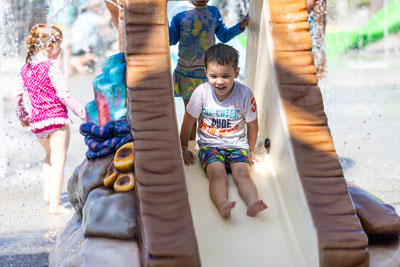 There are so many fun splash products and design possibilities, but one critical consideration is the splash play area’s surface. Kelsi Goss is vice president of design at a Minneapolis-based company offering safety surfaces for a variety of applications, and she pointed out that splash pads are playgrounds with water, and similar to playgrounds, they need “certified safety surfacing that enables diverse play types while reducing injury potential.”
There are so many fun splash products and design possibilities, but one critical consideration is the splash play area’s surface. Kelsi Goss is vice president of design at a Minneapolis-based company offering safety surfaces for a variety of applications, and she pointed out that splash pads are playgrounds with water, and similar to playgrounds, they need “certified safety surfacing that enables diverse play types while reducing injury potential.”
She explained that their tiles are certified to NSF/ANSI/CAN Standard 50, “which includes slip-resistance and impact absorption criteria for interactive water play venues.”
Goss said that third-party testing was conducted to ensure that their tiles maintain their “cushioned and slip-resistant properties with exposure to chemicals and UV.” The tiles are also “extremely cleanable with 99.9% reduction of bacteria after cleaning when following the Model Aquatic Health Code (MAHC) process. Our closed-cell material doesn’t harbor any growth.”
When it comes to surface designs, Goss said their different themes and patterns are often good starting points for customers. “They can also be customized with different colors or… our themed inlays, which can be placed in tiles to feature imagery like fish, flowers, birds and farm animals.”
The surfaces are also “fully customizable with limitless design possibilities.” A new product line “empowers brands that dream of creating iconic, highly immersive, themed aquatic environments from the ground up. Sometimes customers will dream up their own designs and sometimes they’ll tell us what they love or want to achieve, and we help bring their ideas to life.”
Some customers get really creative, according to Goss, and games are even added to surfaces. “Some include checkerboards, four square, hopscotch or Twister-like options. Others have included hopping opportunities like lily pads, paths to follow or treasure hunts. One customer created an entire splash pad that looked like a Candyland board.” She said some engaging shapes have included life-sized designs with things like surfboards, whales or dolphins.
But Goss said their work takes on a bigger purpose. “Rethinking the way that aquatic spaces should be designed to accommodate all guests, literally from the ground up, has brought so much purpose to the work we do. We feature grant opportunities that benefit facilities specifically looking to become more accessible and inclusive.”
She said they’ve recently received their Certified Autism Resource certification from the International Board of Credentialing and Continuing Education Standards (IBCCES). “Our most important core value is people.”
Aside from the surfacing, theming is still very popular in splash pad designs. “We’re doing lots of theming these days, especially custom themes,” said Thomas. “Mining, sports and farm themes have been very popular over the past year.” Tracy said his company has developed more than 450 different products with themes based on requests from customers. Just a few of the themes he mentioned include construction, space, Christmas, firehouse, circus, western and pirates. “We can also do custom theming or branded products if requested.”
Splash features are showing up at more waterparks and larger aquatic destinations, and Tracy said it’s essential to include these as splash play areas cater to young families. He pointed out that while teens once dominated these venues to take advantage of the large adventure attractions, operators are finding that younger kids are increasingly drawn as well. “The younger demographic have ‘pester power’ which drives the whole family to the venue, with longer length of stay, greatly increasing revenue.” 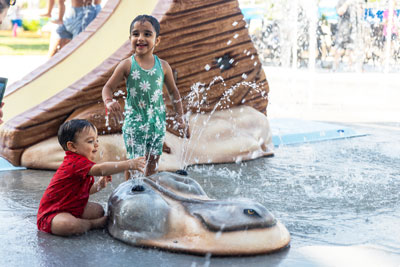
Splash play products continue to make their way indoors as well, though there are extra considerations. “In cooler climates or excessively hot climates, indoor splash pads are a must if one wants to utilize the facility in all seasons,” said Tracy. “Indoor facilities need special attention for the heating, air conditioning and ventilation systems due to high humidity not encountered in outdoor venues.”
Tracy suggested that aquatic play is not only for kids, but also for parents, “because they can relax while there is no worry of deep water. Varying water events and interactivity will keep the youngsters occupied for hours, burning off that never-ending energy and allowing the parents to relax. The family has an all-inclusive, enjoyable day.”
“These pool-less venues are a testament to the innovation in recreational water features, combining safety, fun and aesthetic appeal,” said Lapierre. “They’re a great way to beat the heat and enjoy water play without the need for swimming skills or lifeguards.”
Added Skogen, “Water is inherently inclusive, and our splash pads are designed to be welcoming spaces where everyone is invited to play. We love seeing people of all abilities enjoying and exploring the water in their own unique ways.” RM
Photos courtesy of Water Odyssey
For More Information:
www.waterodyssey.com


